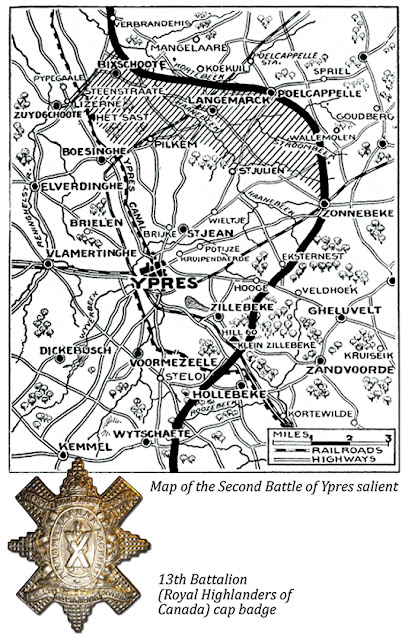Canadian Connections
Prior to the First World War
the Canadian military force amounted to 3,110 men of a regular army and a
fledging navy. 620,000 Canadians answered the call to arms and enlisted to
fight for the British Empire, at the outbreak of the First World War, of this figure
67,000 had been killed with a further 250,000 being wounded by 1918. In this
piece about Remembrance, one man comes to the forelight who has a connection
with Swansea.
I want
to take you back to 1915, following the chronicled events of the 13th Battalion
(Royal Highlanders of Canada), Canadian Expeditionary Force, consisting of
100-200 men. They moved up to the Front for the first time on 16th April, at
St. Jean near St. Julien, western Belgium. The evening before the Second Battle
of Ypres, (22nd April – 5th May), the battalion progressed to the Front Line,
without any casualties. 23rd April, the Germans performed the barbaric act of
releasing chlorine-gas for the first time. The attack was against the French,
who were holding the line left of the Canadians. The French capitulated,
causing confusion when retreating back to the village of St. Julien. During
that evening of the 23rd, the 13th Battalion, still holding their lines fast,
were also gassed and shelled. 24th April, was the first day of the Battle of
St. Julien (24th April – 5th May). During the early morning the Canadians were
re-forming, re-organizing their lines, when the Germans released another gas
cloud. Officers gave the order for men to urinate on their handkerchiefs and
place them over their mouths and noses as protection. The Canadians, including
the 13th Battalion held the line until 7.30 in the morning, when they were
forced back to the G.H.Q. trenches. The Germans captured the village of St.
Julien which then remained in their Front Line for 2 years. During the first
day of the battle, 102 men from the 13th Battalion were killed as a result of
shelling or gas poisoning. The names of these men are inscribed on the Menin
Gate Memorial, situated at Ypres.
We move now to this
year. Since the beginning of the year I have picked interesting stories that
were published in the newspapers, covering 1914 – 1918. I post my findings on
my Facebook Page, Swansea War Dead – First World War. Feel free to join my page
and to make comments.
On 13th May my post
included an article entitled Swansea Canadian Killed In Action, which had been
published in the Cambria Daily Leader, announcing
the death of George Wilfred Imrie. The Herald of Wales
and Monmouthshire Recorder, published on the 22nd May 1915,
had an article with an accompanying photograph of G. W. Imrie. With some
research, I discovered that Imrie was one of the 102 to be killed on the 24th
April 1915.
By chance I was
chatting to Simon in the Bay studio and he mentioned that his
great-uncle had been killed during the First World War – George Wilfred Imrie. Simon’s middle name is Imrie – his maternal
grandmother’s maiden name.
I told them of my
research work, and shared with Simon my findings
and the photograph.
What
more information is there about George? He was born in Mumbles in 1889, and
educated at Brynmill Board School. During 1912, he emigrated to Canada, on
board the Royal George where he settled in Montreal employed as a clerk at the
Nichols’ Chemical Works. He never married. He reached the rank of Sergeant in
the army.
Copyright – The Bay
Magazine – July 2018




Comments
Post a Comment